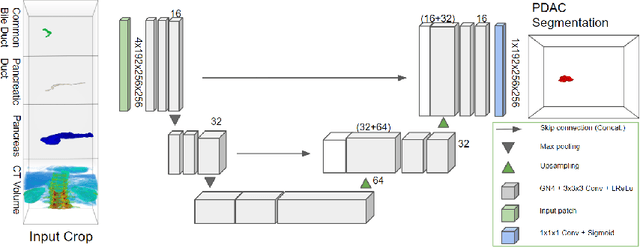Joost Nederend
Segmentation-based Assessment of Tumor-Vessel Involvement for Surgical Resectability Prediction of Pancreatic Ductal Adenocarcinoma
Oct 01, 2023



Abstract:Pancreatic ductal adenocarcinoma (PDAC) is a highly aggressive cancer with limited treatment options. This research proposes a workflow and deep learning-based segmentation models to automatically assess tumor-vessel involvement, a key factor in determining tumor resectability. Correct assessment of resectability is vital to determine treatment options. The proposed workflow involves processing CT scans to segment the tumor and vascular structures, analyzing spatial relationships and the extent of vascular involvement, which follows a similar way of working as expert radiologists in PDAC assessment. Three segmentation architectures (nnU-Net, 3D U-Net, and Probabilistic 3D U-Net) achieve a high accuracy in segmenting veins, arteries, and the tumor. The segmentations enable automated detection of tumor involvement with high accuracy (0.88 sensitivity and 0.86 specificity) and automated computation of the degree of tumor-vessel contact. Additionally, due to significant inter-observer variability in these important structures, we present the uncertainty captured by each of the models to further increase insights into the predicted involvement. This result provides clinicians with a clear indication of tumor-vessel involvement and may be used to facilitate more informed decision-making for surgical interventions. The proposed method offers a valuable tool for improving patient outcomes, personalized treatment strategies and survival rates in pancreatic cancer.
Improved Pancreatic Tumor Detection by Utilizing Clinically-Relevant Secondary Features
Aug 06, 2022



Abstract:Pancreatic cancer is one of the global leading causes of cancer-related deaths. Despite the success of Deep Learning in computer-aided diagnosis and detection (CAD) methods, little attention has been paid to the detection of Pancreatic Cancer. We propose a method for detecting pancreatic tumor that utilizes clinically-relevant features in the surrounding anatomical structures, thereby better aiming to exploit the radiologist's knowledge compared to other, conventional deep learning approaches. To this end, we collect a new dataset consisting of 99 cases with pancreatic ductal adenocarcinoma (PDAC) and 97 control cases without any pancreatic tumor. Due to the growth pattern of pancreatic cancer, the tumor may not be always visible as a hypodense lesion, therefore experts refer to the visibility of secondary external features that may indicate the presence of the tumor. We propose a method based on a U-Net-like Deep CNN that exploits the following external secondary features: the pancreatic duct, common bile duct and the pancreas, along with a processed CT scan. Using these features, the model segments the pancreatic tumor if it is present. This segmentation for classification and localization approach achieves a performance of 99% sensitivity (one case missed) and 99% specificity, which realizes a 5% increase in sensitivity over the previous state-of-the-art method. The model additionally provides location information with reasonable accuracy and a shorter inference time compared to previous PDAC detection methods. These results offer a significant performance improvement and highlight the importance of incorporating the knowledge of the clinical expert when developing novel CAD methods.
 Add to Chrome
Add to Chrome Add to Firefox
Add to Firefox Add to Edge
Add to Edge